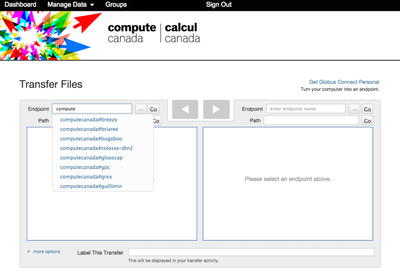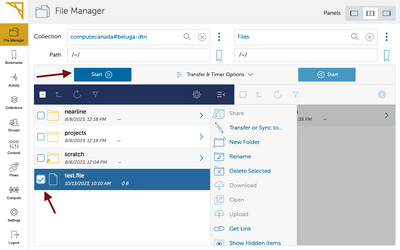Globus
Globus is a service for fast, reliable, secure data movement. Designed specifically for researchers, Globus has an easy-to-use interface with background monitoring features that automate the management of file transfers between any two resources, whether they are at Compute Canada, another supercomputing facility, a campus cluster, lab server, desktop or laptop.
Globus leverages GridFTP for its transfer protocol but shields the end user from complex and time consuming tasks related to GridFTP and other aspects of data movement. It improves transfer performance over GridFTP, rsync, scp, and sftp, by automatically tuning transfer settings, restarting interrupted transfers, and checking file integrity.
Globus can be accessed via the main Globus website or via the Compute Canada Globus portal at https://globus.computecanada.ca.
Using Globus[edit]
Go to http://globus.computecanada.ca. Your "existing organizational login" is your CCDB account. Ensure that "Compute Canada" is selected in the drop-down, then click Continue. Supply your CCDB username and password on the Compute Canada MyProxy page which appears.
To Start a Transfer[edit]
(1) If the "Transfer Files" page is not already showing (see image), select it from the "Manage Data" menu.
(2) Select a site in the "Endpoint" field. You may browse the drop-down list or type the name into the Endpoint field to find the desired endpoint. All Compute Canada resource names are prefixed with computecanada#.
You will be prompted to activate the endpoint. The appearance of this depends on which site is hosting the endpoint. For example, if you are activating the endpoint for Silo, which is in WestGrid, you will be asked for your WestGrid username and password. If you are unsure of how to proceed, check the site-specific documentation (links below):
- WestGrid Globus documentation
- Calcul Québec Globus documentation
- ACEnet Globus documentation
- SciNet: Select
computecanada#gpcand you will be redirected to a page requesting your SciNet username and password to activate the endpoint.
(3) Select a second endpoint and activate it the same way.
(4) Once an endpoint has been activated you should see a list of directories and files which you can navigate by double-clicking on directories and using the "up one folder" button. Highlight a file or directory that you want to transfer by single-clicking on it. Control-click to highlight multiple things. Then click the blue arrow to initiate the transfer. The task will be queued, and will begin shortly. You will receive an email (at the email address you registered with your Globus account) when the transfer is complete. You can also monitor in-progress transfers and view details of completed transfers from the Activity tab on the Globus site.
Options[edit]
Globus provides several other options in the "Transfer Settings" area at the bottom of the Transfer Files page. Here you can direct Globus to
- sync - only transfer new or changed files
- delete files on destination that do not exist on source
- preserve source file modification times
- verify file integrity after transfer (on by default)
- encrypt transfer
Note that enabling encryption significantly reduces transfer performance, so it should only be used for sensitive data.
Personal Computers[edit]
Globus provides a desktop client, Globus Connect Personal, to make it easy to transfer files to and from a personal computer running Windows, MacOS X, or Linux.
To install Globus Connect Personal:
(1) Go to the Compute Canada Globus portal and log in if you have not already done so.
(2) From the Manage Data menu, select Endpoints, and then click on “add Globus Connect Personal endpoint”.
(3) Enter an endpoint name, which you will use to access the computer you will be installing Globus Connect Personal on. Example: MacLaptop or WorkPC.
(4) Click the “Generate Setup Key” button. Copy the key to your computer’s clipboard, then click the download link for your operating system.
(5) Install the program. Once it is installed, run the Globus Connect Personal program.
(6) The first time you run the program, enter the Setup Key from step 4 in the box that pops up.
(7) You should now be able to access the endpoint through Globus. The full endpoint name is [your username]#[name from step 3] Example: smith#WorkPC
For more information see the Globus.org how-to pages, particularly:
- Globus Connect Personal for Mac OS X
- Globus Connect Personal for Windows
- Globus Connect Personal for Linux
Further Reading[edit]
Globus sharing makes collaboration between users easy. Sharing enables people to access files stored on your account on a Compute Canada system even if the other user does not have an account on that system. Files can be shared with any user, anywhere in the world, who has a Globus account. See Sharing Files With Globus, and https://support.globus.org/entries/23602336-Sharing-Data-using-Globus.
Globus groups provide an easy way to manage permissions for sharing with multiple users. When you create a group, you can use it from the sharing interface to quickly control access to a share for multiple users simultaneously. See Globus Groups and https://support.globus.org/entries/23586412-Managing-Globus-Online-Groups-for-Data-Sharing
Support and More Information[edit]
If you would like more information on Compute Canada’s use of Globus, or require support in using this service, please send an email to globus@computecanada.ca and provide the following information:
- Name
- Compute Canada Role Identifier (CCRI)
- Institution
- Inquiry or issue. Be sure to indicate which sites you want to transfer to and from.

